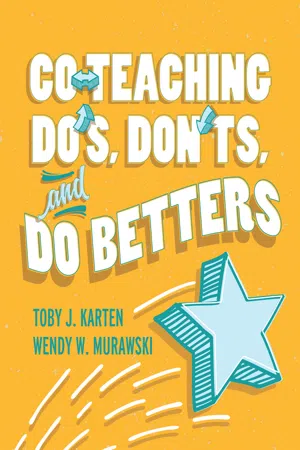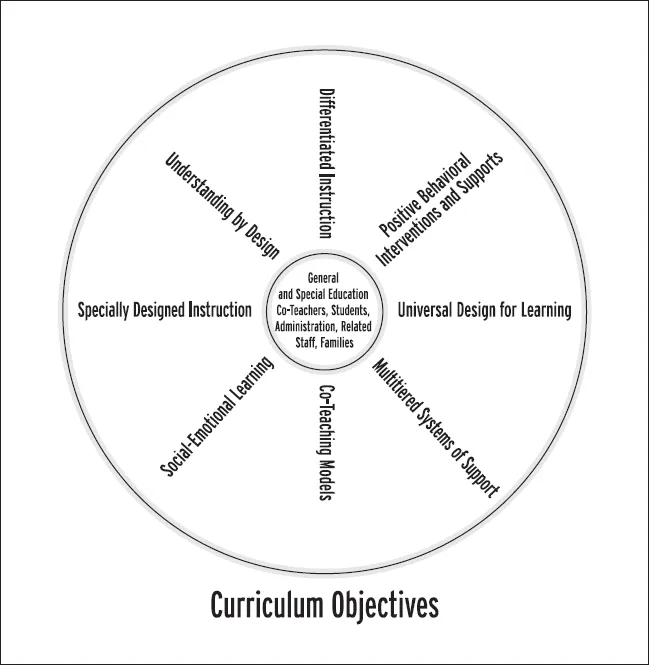![]()
Chapter 1
The Co-Teaching Spokes and Inclusive Principles: The Do's, Don'ts, and Do Betters of a Co-Teaching Environment
. . . . . . . . . . . . . . . . . . . .
Collaborative Goals
1.1: Establish the co-teaching spokes as the evidence-based practices that support effective co-teaching.
1.2: Implement the evidence-based practices to strengthen the effectiveness of the environment.
1.3: Decide what is nonnegotiable with co-teaching partners and collaborative staff.
1.4: Think ours, never mine.
1.5: Maximize successes through shared responsibilities of the inclusion principles.
1.6: Value flexibility, respect, integrity, time, and honesty.
Do's ↑
Vary co-teaching models (CTM).
Establish Multitiered Systems of Support (MTSS) as an instructional framework.
Be proactive with Universal Design for Learning (UDL).
Provide Positive Behavioral Interventions and Supports (PBIS).
Value differentiated instruction (DI).
Plan lessons with the Understanding by Design framework (UbD framework).
Implement specially designed instruction (SDI).
Respect the importance of social-emotional learning (SEL).
Don'ts ↓
Have one co-teacher viewed as the "real" one.
Provide core instruction during Tiers 2 or 3.
Mandate instead of invite.
Stay on the honeymoon too long.
Look for a co-teaching or inclusion formula.
Do Betters ★
Establish co-teaching norms.
Honor student diversity and each individual learner.
Demonstrate inclusion through more than physical presence.
Model, scaffold, reinforce, and enrich with inclusion principles.
Best Practices: The Do's
Co-teaching occurs when two educators, typically a special education (SE) and a general education (GE) teacher, work together in an inclusive classroom. The Individuals with Disabilities Education Act (IDEA) requires school districts to educate students with disabilities in their least restrictive environment to the maximum extent appropriate with the provision of supplementary aids and supports (U.S. Department of Education [OSERS], 1994). IDEA does not use the word inclusion, but the general education classroom is considered the first option of service (Karten, 2015).
Inclusion embraces the notion that learners of different ability levels are educated side by side (Friend, 2015/2016; Karten, 2016). Inclusion occurs with and without a co-teacher in the room, but if there are two educators present, then the responsibilities translate to both the general and the special educator teaching all learners. More students can be supported as co-teachers work collaboratively to implement evidence-based practices and co-taught interventions. For example, students who are culturally and linguistically diverse often struggle in school, with disability and diversity sometimes acting as a double jeopardy (Fallah & Murawski, 2018). The co-taught classroom can truly be an unrestrictive environment that offers students with and without exceptionalities the supports and services required to learn side by side.
Ideally, co-teachers share responsibilities for all students, including those with and without exceptionalities and those with cultural and linguistic diversity. In reality, the co-teaching relationships from one class to the next across schools and even within the same school often differ based on the schedule, supports, resources, content, and diversity of the students and the co-teachers. Stein (2016) views co-teaching through the lens of it being a teaching experience rather than a teaching assignment. We begin our collective experience with the first collaborative goal.
Collaborative Goal 1.1: Establish the co-teaching spokes as the evidence-based practices that support effective co-teaching.
Just as spokes radiate from the hub of a wheel to ensure movement and prevent wobbling, co-teaching has its own spokes that allow this shared instructional model to be effective. Throughout this chapter and subsequent ones, we describe these spokes in more detail, providing elementary and secondary curriculum lesson connections.
Co-teaching requires more than merely putting together two educators with differing expertise. The eight spokes portrayed in Figure 1.1 depict the evidence-based practices with which co-teachers need to be not only familiar but also comfortable and eventually at mastery. These big topics are critical to the success of the inclusive classroom, and co-teachers can use these spokes to help build their competence together. The spokes rest on the curriculum objectives, which are the ultimate goal for most lessons. When co-teachers discuss the curriculum objectives and use the collaborative goals offered in these chapters, in conjunction with the co-teaching spokes, the magic known as learning can happen in that co-taught classroom!
Figure 1.1. Co-Teaching Spokes
Copyright 2019 by Toby J. Karten
Collaborative Goal 1.2: Implement the evidence-based practices to strengthen the effectiveness of the environment.
Evidence-based practices allow learning to move forward. These practices are interrelated, as the circular graphic indicates, with general and special education co-teachers, families, students, and administration at the core and the curriculum objectives at the base. In order for co-teaching to be successful, evidence-based practices must be emphasized, with implementation not just desired but expected. This ensures that your curriculum is attainable for the students and, more important, for advancements to occur for learners of all levels. Without these evidence-based practices, the curriculum may be too difficult for all learners to grasp.
Co-teachers in a general education environment look at the academic, social, emotional, behavioral, communicative, physical, and curricular hoops that students will experience and figure out how they will collaboratively tackle those differences. More explanation and application about these evidence-based practices, offered here as the co-teaching spokes, will be discussed throughout this book.
↑ Vary Co-Teaching Models (CTM)
Though co-teaching itself has been in place in special and general education since the early 1980s (e.g., Garvar & Papania, 1982), Marilyn Friend and Lynne Cook introduced the original five co-teaching models in the early 1990s (1992):
- One teach, one support
- Team teaching
- Station teaching
- Alternative teaching
- Parallel teaching
In later works, they added a sixth approach by breaking up one teach, one support to include both one teach, one assist and one teach, one observe (Friend & Cook, 1996). We reference these initial five co-teaching models and offer additional elaboration and collaborative practices with K–12 lesson applications as we connect these models to classroom realities.
After providing a short introduction to these five CTMs and the foundational pros and cons, we'll continue to share strategies on each approach that are student-based and not solely attached to one particular model so that you and your partner can ultimately expand your co-teaching practices.
One teach, one support. This model is also known as lead and support; one teach, one assist; one teach, one observe; or supportive co-teaching (Bauwens, Hourcade, & Friend, 1989; Friend & Cook, 2017; Hughes & Murawski, 2001; Villa, Thousand, & Nevin, 2013). In this approach, as the title suggests, one of the co-teachers takes the lead for direct instruction while the other engages in support activities. These may include circulating, collecting data, monitoring behavior or comprehension, managing materials, taking roll, setting up technology, and so forth. Either teacher may take the lead. This approach is the most commonly used (Weiss & Lloyd, 2003) because of its simplicity and familiarity; it also requires the least amount of collaboration, communication, and planning. That said, co-teachers should ensure that the individual in the support role is doing something that is meaningful, not just walking around or standing against the back wall watching. The goal is to move beyond one teach, one support (Spencer, 2012).
Team teaching. This model is also known as teaming (Friend & Bursuck, 2019; Karten, 2015). Though some use the term co-teaching synonymously with team teaching, team teaching is the approach wherein both teachers share the stage. Co-teachers select this approach when they want to model information, role-play something, debate a topic or instructional strategy in front of students, or show two different ways of tackling a task (Murawski, 2009). While it is fun for students to see both of their teachers interacting in front of the class, it can also model communication and collaboration. Unfortunately, team teaching can be overused as well. When both teachers are in front of the class, no one is engaged with small groups or individuals. Another potential drawback is that the class can begin to feel like a tennis match, with verbiage going back and forth from teacher to teacher, ultimately confusing students or just taking twice as long to cover the same content. Teachers who choose to do team teaching should select it for a particular purpose; use it strategically to get attention, demonstrate parity, and make a point; and then return to a regrouping type of co-teaching approach.
Station teaching. This model is also known as centers or rotation teaching (Hughes & Murawski, 2001; Karten, 2005, 2015). While elementary teachers use centers often, station teaching is less frequently observed in secondary classes, as middle and high school teachers may worry that it takes time away from direct content instruction, interferes with the pacing guide, or perhaps is simply too elementary. Although none of these is accurate, we'll continue that discussion in the Do Betters section.
Station teaching is different than centers or cooperative learning in that students are placed in (or self-select) a station and then rotate through the various stations. Figure 1.2 offers an example of a station that provides multiple means of student engagement as learners demonstrate their knowledge to solidify the concepts learned.
Figure 1.2. Performance Station
Directions: Each group selects one of the following to share what they learned.
1. Write a script for a short skit, television commercial, or YouTube video (check out www.showme.com or https://explaineverything.com/). Remember that your characters must relate to the topic. It's your chance to make the learning come alive! Be creative!
2. Create a poem, song, video, game, advertisement, or dance about the reading. Again, concentrate on stories or textbook concepts that we learned.
3. If your group has another idea, check with the teachers. Available classroom resources can be used (e.g., digital cameras, recorders, dictionaries, tablets, thesauruses, rhyming lists, textbooks, websites).
Signatures of Cooperative Performers (who created the work together):
________________________________________________________
________________________________________________________
________________________________________________________
________________________________________________________
________________________________________________________
________________________________________________________
Source: From Inclusion Strategies That Work! Research-Based Methods for the Classroom (3rd ed., p. 222), by T. J. Karten, 2015, Thousand Oaks, CA: Corwin. Copyright 2015 by Corwin. Ada...

